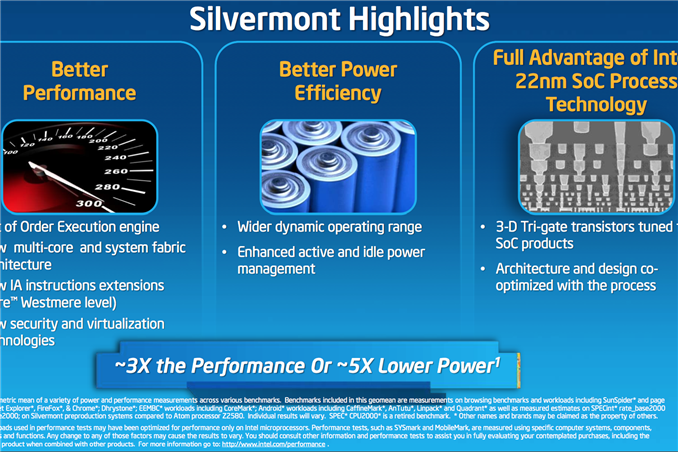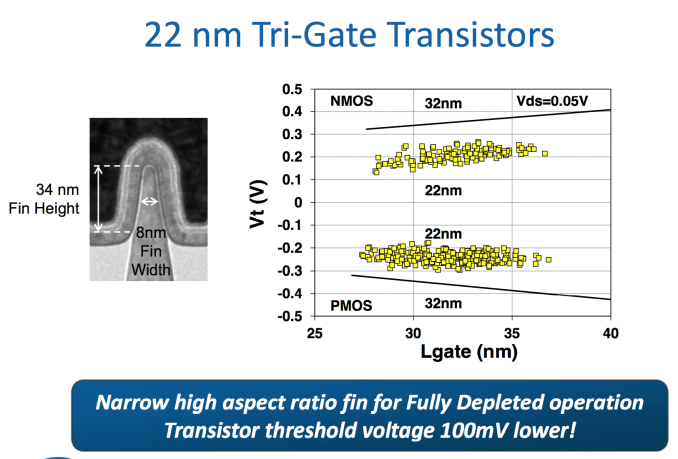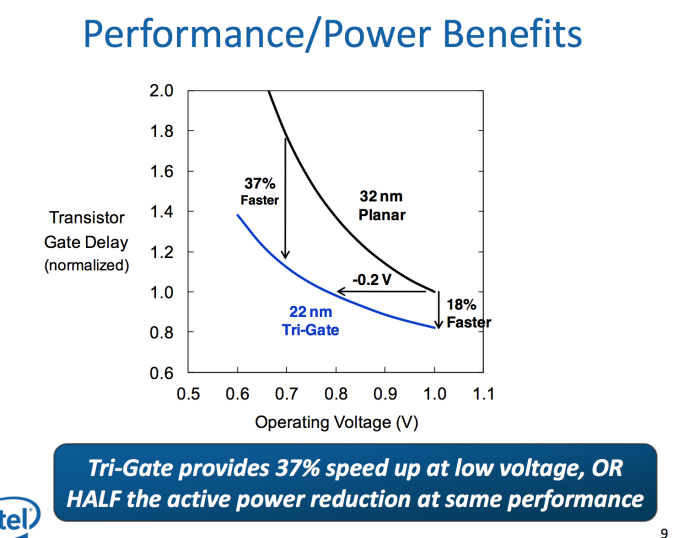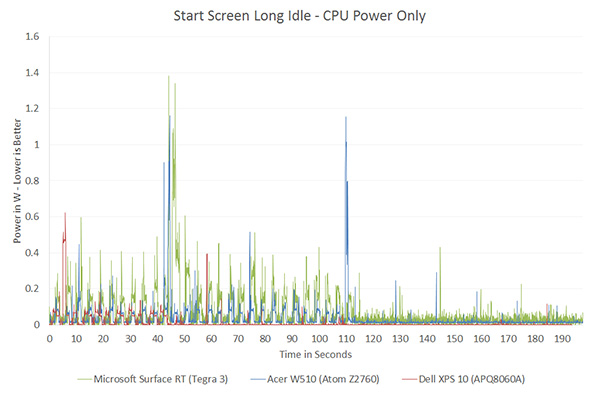Intel’s Silvermont Architecture Revealed: Getting Serious About Mobile
by Anand Lal Shimpi on May 6, 2013 1:00 PM EST- Posted in
- CPUs
- Intel
- Silvermont
- SoCs

The most frustrating part about covering Intel’s journey into mobile over the past five years is just how long it’s taken to get here. The CPU cores used in Medfield, Clover Trail and Clover Trail+ are very similar to what Intel had with the first Atom in 2008. Obviously we’re dealing with higher levels of integration and tweaks for further power consumption, but the architecture and much of the core remains unchanged. Just consider what that means. A single Bonnell core, designed in 2004, released in 2008, is already faster than ARM’s Cortex A9. Intel had this architecture for five years now and from the market’s perspective, did absolutely nothing with it. You could argue that the part wasn’t really ready until Intel had its 32nm process, so perhaps we’ve only wasted 3 years (Intel debuted its 32nm process in 2010). It’s beyond frustrating to think about just how competitive Intel would have been had it aggressively pursued this market.
Today Intel is in a different position. After acquisitions, new hires and some significant internal organizational changes, Intel seems to finally have the foundation to iterate and innovate in mobile. Although Bonnell (the first Atom core) was the beginning of Intel’s journey into mobile, it’s Silvermont - Intel’s first new Atom microarchitecture since 2008 - that finally puts Intel on the right course.
Although Silvermont can find its way into everything from cars to servers, the architecture is primarily optimized for use in smartphones and then in tablets, in that order. This is a significant departure from the previous Bonnell core that was first designed to serve the now defunct Mobile Internet Devices category that Intel put so much faith in back in the early to mid 2000s. As Intel’s first Atom architecture designed for mobile, expectations are high for Silvermont. While we’ll have to wait until the end of the year to see Silvermont in tablets (and early next year for phones), the good news for Intel is that Silvermont seems competitive right out of the gate. The even better news is that Silvermont will only be with us for a year before it gets its first update: Airmont.
 Intel made this announcement last year, but Silvermont is the beginning of Intel’s tick-tock cadence for Atom. Intel plans on revving Atom yearly for at least the next three years. Silvermont introduces a new architecture, while Airmont will take that architecture and bring it down to 14nm in 2014/2015. One year later, we’ll see another brand new architecture take the stage also on 14nm. This is a shift that Intel needed to implement years ago, but it’s still not too late.
Intel made this announcement last year, but Silvermont is the beginning of Intel’s tick-tock cadence for Atom. Intel plans on revving Atom yearly for at least the next three years. Silvermont introduces a new architecture, while Airmont will take that architecture and bring it down to 14nm in 2014/2015. One year later, we’ll see another brand new architecture take the stage also on 14nm. This is a shift that Intel needed to implement years ago, but it’s still not too late.
Before we get into an architectural analysis of Silvermont, it’s important to get some codenames in order. Bonnell was the name of the original 45nm Atom core, it was later shrunk to 32nm and called Saltwell when it arrived in smartphones and tablets last year. Silvermont is the name of the CPU core alone, but when it shows up in tablets later this year it will do so as a part of the Baytrail SoC and a part of the Merrifield SoC next year in smartphones.
22nm
To really understand the Silvermont story, you need to first understand Intel’s 22nm SoC process. Two years ago Intel announced its 22nm tri-gate 3D transistors, which would eventually ship a year later in Intel’s Ivy Bridge processors. That process wasn’t suited for ultra mobile. It was optimized for the sort of high performance silicon that was deployed on it, but not the ultra compact, very affordable, low power silicon necessary in smartphones and tablets. A derivative of that process would be needed for mobile. Intel now makes two versions of all of its processes, one optimized for its high performance CPUs and one for low power SoCs. P1270 was the 22nm CPU process, and P1271 is the low power SoC version. Silvermont uses P1271. The high level characteristics are the same however. Intel’s 22nm process moves to tri-gate non-planar transistors that can significantly increase transistor performance and/or decrease power.
This part is huge. The move to 22nm 3D transistors lets Intel drop threshold voltage by approximately 100mV at the same leakage level. Remember that power scales with the square of voltage, so a 100mV savings depending on what voltage you’re talking about can be very huge. Intel’s numbers put the power savings at anywhere from 25 - 35% at threshold voltage. The gains don’t stop there either. At 1V, Intel’s 22nm process gives it an 18% improvement in transistor performance or at the same performance Intel can run the transistors at 0.8V - a 20% power savings. The benefits are even more pronounced at lower voltages: 37% faster performance at 0.7V or less than half the active power at the same performance.
The end result here is Intel can scale frequency and/or add more active logic without drawing any more power than it did at 32nm. This helps at the top end with performance, but the vast majority of the time mobile devices are operating at very lower performance and power levels. Where performance doesn’t matter as much, Intel’s 22nm process gives it an insane advantage.
If we look back at our first x86 vs. ARM performance data we get a good indication of where Intel’s 32nm process had issues and where we should see tangible improvements with the move to 22nm:
Qualcomm’s 28nm Krait 200 was actually able to get down to lower power levels than Intel could at 32nm. Without having specific data I can’t say for certain, but it’s extremely likely that with Silvermont Intel will be able to drive down to far lower power levels than anything we’ve ever measured.
Understanding what Intel’s 22nm process gives it is really key to understanding Silvermont.













174 Comments
View All Comments
PolarisOrbit - Monday, May 6, 2013 - link
Re: FSBIntel tried to get rid of the FSB several years ago, but it was seen as anti-competitive because they simultaneously locked out 3rd parties like Nvidia Ion. One lawsuit later, Intel was bound to keep the FSB in their low power architectures until 2013 for 3rd party support. Basically Intel wasn't playing fair and Nvidia burned their ship.
DanNeely - Tuesday, May 7, 2013 - link
There was no usable FSB in anything beyond the first series of atom chips. The rest still had it within the die to connect the CPU with the internal northbridge; but the only external interface it offered was 4 PCIe2(?) lanes. ION2 connected to them; not to FSB.Kevin G - Tuesday, May 7, 2013 - link
Actually Intel is to keep PCI-e on their chips until 2016 by that anti-trust suit. This allows 3rd part IP, like nVidia's ION, to work with Intel's SoC designs.tipoo - Monday, May 6, 2013 - link
This makes me wonder if companies that make in-house SoCs (I guess Apple in specific, since Samsung also sells them to others while Apple just does it for themselves) will ever switch mobile devices to Intel if they just can't match the performance per watt of this and future Atom cores.tipoo - Monday, May 6, 2013 - link
Also won't the much anticipated SGX 600 series/Rogue be out by around then? That's the GPU that's supposed to take these mobile SoCs to the 200Gflop territory which the 360/PS3 GPUs are around.xTRICKYxx - Tuesday, May 7, 2013 - link
I would think Apple would (or any company) would want all of their software running on the same architecture/platform if they could.R0H1T - Tuesday, May 7, 2013 - link
And kill what a billion or so iDevices sold with incompatibility ? Me thinks you dunno what you're talking about !CajunArson - Monday, May 6, 2013 - link
Did somebody pay you to post that reply? Because if so, they aren't getting their money's worth.Silvermont Atoms are targeted at smartphones in 2-core configurations and tablets in the 4-core Baytrail configurations. Their power consumption is in a completely different league than even the low-end Temash parts. Let me reiterate: a Temash with a 4 watt TDP is going to have substantially higher real-world power consumption than even a beefy Baytrail and will likely only compete with the microserver Atom parts where Intel intentionally targets a higher power envelope.
I'm sure you can't wait to post benchmarks of a Kabini netbook with a higher power draw than Haswell managing to beat a smartphone Atom as proof that AMD has "won" something, but for those of us on planet earth, these Silvermont parts are very interesting and we appreciate hard technical information on the architecture.
nunomoreira10 - Tuesday, May 7, 2013 - link
Jaguar will be available on fanless designs wille haswell wont, you cant realy compare them.The facto is intel still doesn't hás a good enougf CPU for a good experiency on a legacy windows 8 fanless design, there is this big hole in the market that AMD is trying to seek.
raghu78 - Monday, May 6, 2013 - link
Intel silvermont is the start of the Intelization of the mobile world. within the next 2 - 3 years Intel should have bagged Apple , Google or Samsung. with the world's best manufacturing process which is atleast 2 - 3 years ahead of other foundries and Intel's relentless tick - tock chip development cadence the ARM crowd is going to be beaten to a pulp. Qualcomm might survive the Intel juggernaut but Nvidia will not.